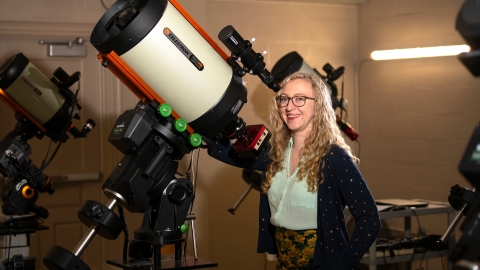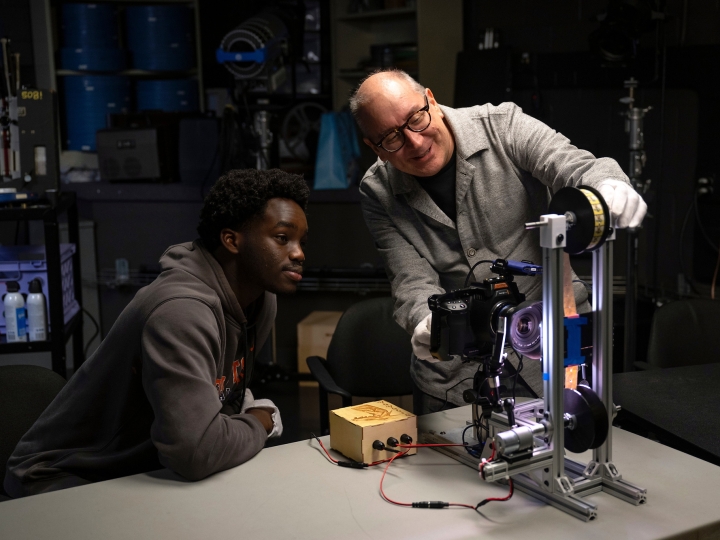
Bucknell's Villadsen Co-discovers Space Radiation Belt
May 15, 2023
Professor Jackie Villadsen, physics & astronomy, stands by a telescope at the Bucknell Observatory. Photo by Emily Paine, Communications

An Earth-sized radio array discovers an extra solar radiation belt 10 million times brighter than Jupiter's around an ultra-cool dwarf. Artist's rendering by Chuck Carter
Bucknell University Professor Jackie Villadsen, physics & astronomy, is an author on a new study documenting the first radiation belt observed outside of our solar system, using a coordinated array of 39 telescopic satellite dishes across a distance from Hawaii to Germany to capture high-resolution images. The authors photographed the radio waves from a brown dwarf — an object in space that has a mass between a giant planet and a small star — located 17 light-years away from Earth. The images reveal a double-lobed structure comparable to the observed radiation belt shape around Jupiter.
The discovery is the first time astronomers have been able to photograph the source of radio waves. Previously, radiation belts — which play an important role in space exploration — were only known to exist around solar system planets, including Earth and Jupiter. This work shows that radiation belts can exist around planets, brown dwarfs, and even stars.
Melodie Kao, a postdoctoral fellow at the University of California, Santa Cruz, is first author on a paper that reports these new findings today in Nature. Kao emphasized that the discovery was a true team effort, relying heavily on the observational expertise of co-first author Amy Mioduszewski at the National Radio Astronomy Observatory (NRAO), as well as the multiwavelength stellar flare expertise of Villadsen and Evgenya Shkolnik, a professor at Arizona State University's School for Earth and Space Exploration.
"We never knew for sure that they [radiation belts] could exist around things other than planets until this work," Kao says. "Radiation belts had never before been seen outside of our solar system, but our work suggests that such phenomena might be more universal than we originally thought."
"We've shown that the radio waves of this brown dwarf are acting like a planet," Villadsen says. "Brown dwarfs are like the big siblings of exoplanets that are bigger and brighter, which allows us to see them [from the telescope]. For years it's been a mystery why brown dwarfs can make bright radio waves. Our images show that the radio waves come from a radiation belt, which is a donut of high-energy electrons zooming around the edges of this brown dwarf."
The team measured extremely high particle energies that underscore the danger of radiation belts, although this brown dwarf is too far away to be dangerous to Earth.
"If scientists eventually discover close-in exoplanets orbiting this brown dwarf, we know those planets experience a very harsh radiation environment," says Villadsen. "This is true in our own solar system as well. NASA designs space missions to fly around Earth's Van Allen radiation belts instead of through them, to limit human and instrument exposure to the intense radiation environment."
The research team used the High Sensitivity Array, consisting of 39 radio dishes coordinated by the NRAO in the United States, and the Effelsberg Radio Telescope, operated by the Max Planck Institute for Radio Astronomy in Germany, to capture their images. They literally created an Earth-sized satellite telescope stretching from Hawaii to Germany, using a similar coordinated technique that was used to capture images of a black hole in 2017.
"By combining radio dishes from across the world, we can make incredibly high-resolution images to see things no one has ever seen before," Villadsen says. "Our image is comparable to reading the top row of an eye chart in California while standing in Washington, D.C."
Villadsen’s expertise was critical to the project, according to Kao.
"What Jackie brought to the table was this incredibly deep knowledge of radio flares on low-mass stars, on top of the fact that she knows this imaging technique." she says. "She worked very closely with me to figure out the right scientific approach. We really leaned on Jackie's knowledge and expertise to arrive at our conclusions."
The research was supported by NASA and the Heising-Simons Foundation.

